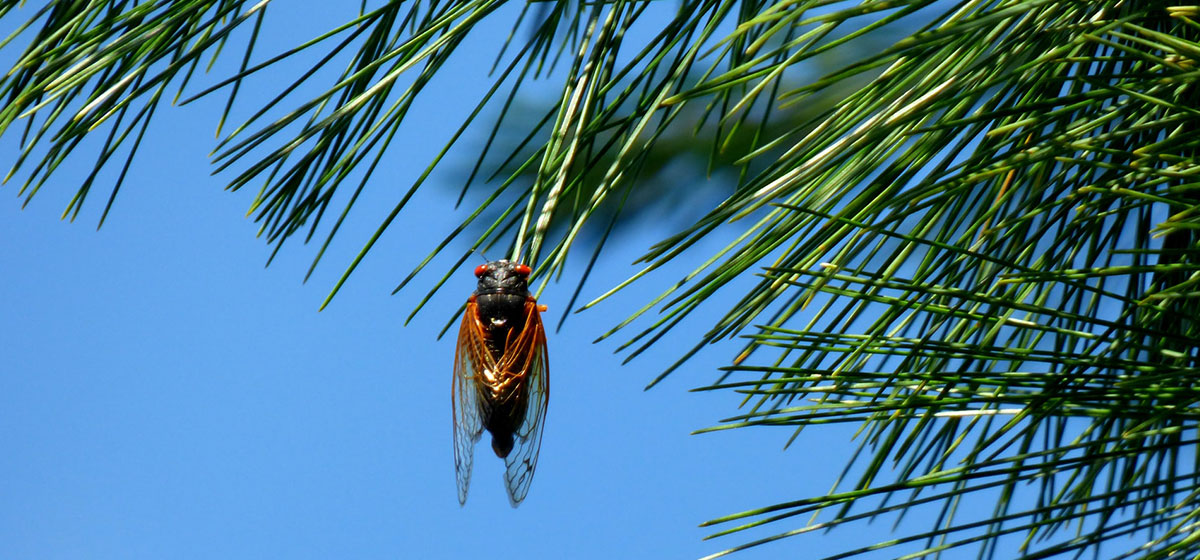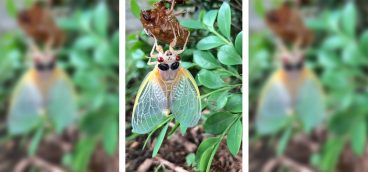A Short Raucous Party

At night, like us, they stop making noise. Tired, I suppose. All day long they scream for a mate among the millions nearby. They don’t have much time, a few weeks at most, to ensure their brood will arise again. Perhaps their screaming is about that particular problem, a coordinated audible insect protest about what seemed like an unfair life cycle. They’d awakened to realize, if they don’t mate soon, their 17 years of waiting will have done no good. Still, in the dark of the night, as I lie in my tent, they quiet. Even cicadas need time for rest.
One source estimates a billion per square mile. A billion. Another quotes a million per acre. How many acres in a square mile? Siri reports 640. Okay, 640 million per square mile. But who’s counting?
The next morning, my wife and I hike. The June day is already warm and humid. We drip sweat soon after starting despite walking downhill. The first part of the hike, we don’t notice them. They are background noise, a high-pitched warble in the distance beyond the next hill. Farther on, they still don’t sound closer as if they are retreating from us or even stranger, as if they exist in some other dimension, able to be heard but never seen. Or does the thump of our boots on the mud-packed trail frighten the males into silence, stopping them from flexing the drum-like tymbals on their abdomens that make that persistent disturbing sound?
We walk on. The sound grows louder though still somehow far away. We stop to listen. Waves roll across the forest, millions joining in the chorus, matching the rhythm, auditioning together. Do the females prefer a mate who willingly joins the choir? Or do the males just appreciate a bawdy ballad together?
Small holes in the packed mud on the trail catch our eyes. They are about 2 millimeters in diameter, and seemingly everywhere. Man-made from the pointed ends of walking sticks? No, just too many holes. Some sort of local worm? Perhaps. And then we spot a hole that holds a single emerging cicada, its soft shell hardening. Of course! The holes are everywhere on the trail and I am sure they were just as densely spaced across the forest floor. A billion seems possible.
Was this one preparing to burst out and fly? Or was it laying the eggs for the next cycle? We seek answers from our phones. No, the Internet teaches us, the females lay their eggs, some 600 or so, not in the ground but in the trees, in slits they carve in small twigs. A relatively temporary home, considering. Once the eggs hatch into nymphs, they drop to the ground and burrow down 8 feet, beneath the level of most human graves, surviving on fluid from plant roots for 17 years. It takes that long for them to mature — about the same as a few humans. How do they count the years so deep in the ground, in complete darkness, with no sunrise at dawn to mark a new day? Again, to the phone. There are theories about a molecular clock (what is that?) and the seasonal change of makeup of the roots’ fluid serving as a mark of time. Why did they evolve so that they’re ready to emerge only after that specific duration — 17 years. Why not 16 or 18?
The questions keep coming.
Why emerge together? Why not space it out? The answer is cruel: to fill the birds’ bellies so full that they no longer want to eat. “Cicadas again,” the hatchlings whine at the repetitive meal. A few lucky cicadas remain to mate.
Imagine the conversation:
“You heading up soon?”
“Yeah. I’ve been waiting it seems like forever to see some light. I’ve heard stories. They seem just unreal.”
“My father told me to be patient. No need to rush. There’s an advantage to being the last one out.”
“I can’t see how that could be. All the good mates will be taken. You know, ‘the early bird gets the worm.’”
“What?”
“Never mind.”
“My father said he was just passing it on. Who was he to question?”
“I know. But don’t you think I’m looking pretty good.”
“Yeah, you’ve changed. Actually, the transformation is amazing. I don’t think I’d recognize you if you didn’t talk.”
“Thanks. I gotta say, I can’t stop thinking about sex. I’m going nuts down here.”
“Do what you think best. I’m going to hold off for a few days.”
“Nobody else is waiting.”
“There’s a few of us, actually.”
“Well… best of luck to you. Maybe we’ll run into each other up there.”
I doubt it. “Could be. Could be.”
My wife and I take a short break to drink and rest. I set my small pack on a log. A live cicada lands on the front pocket. A couple of inches long, golden brown, its wings translucent, it sits motionless, silent. Its body is complex though perfectly symmetric, with ridges and markings that speak to miracles of cellular and organ function underneath. Is it looking at me as I stare at it? Or smelling the sweat that soaks my shirt? Is it paralyzed in fear at this giant, malodorous thing looking down at it? Or is it much smarter than I think, alighting near me knowing that a hungry bird would not dare snatch it while I stand so close. Perhaps it’s resting after a meal of twig juice? Or dying? If I flick it off my pack, would it fly or just fall to the ground to join the many carcasses that now seem so obvious?
Or is it pleading with me to help it understand how it could be that the raucous party will be over so soon, that its purpose in life is complete, that the only thing left to do is die?





